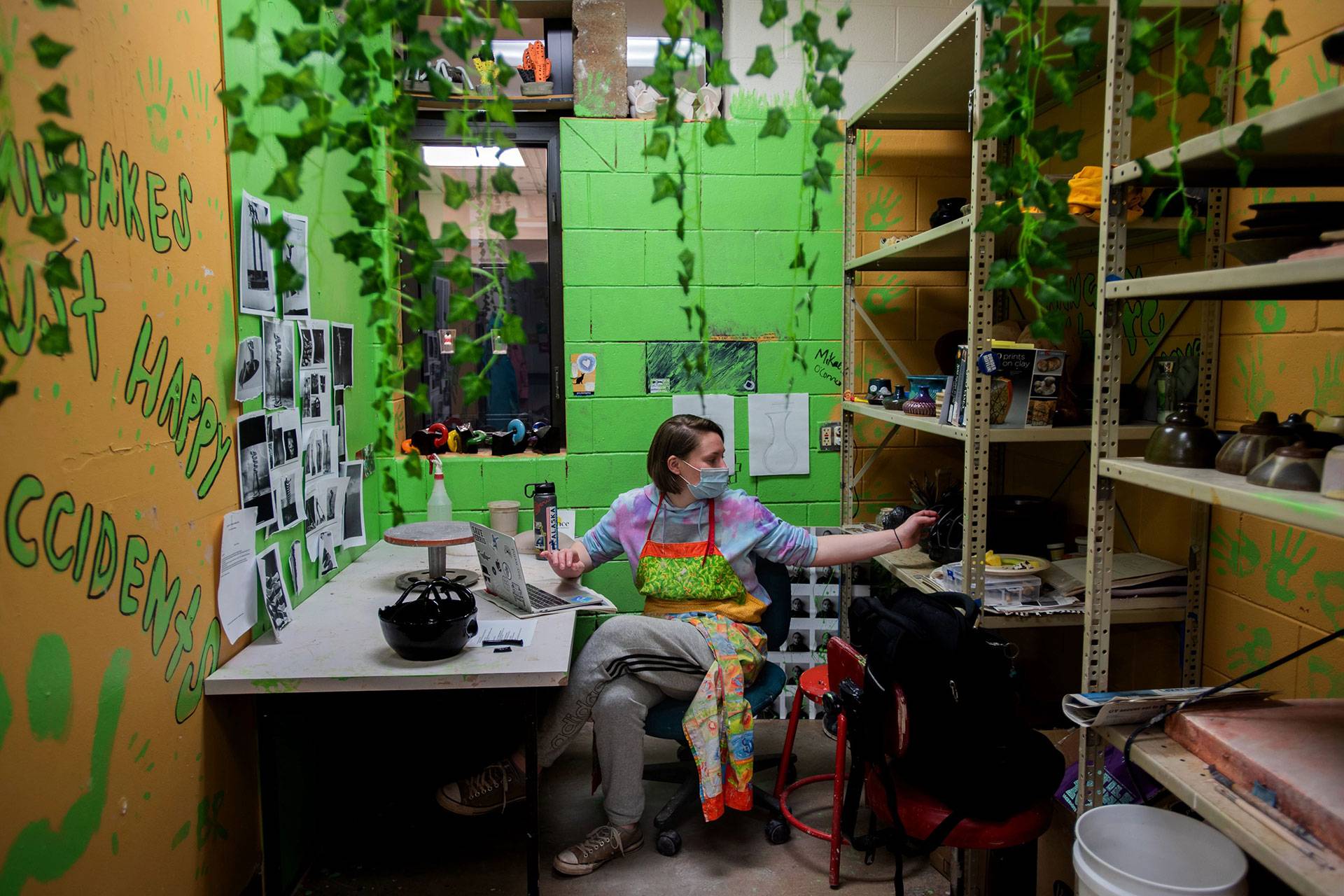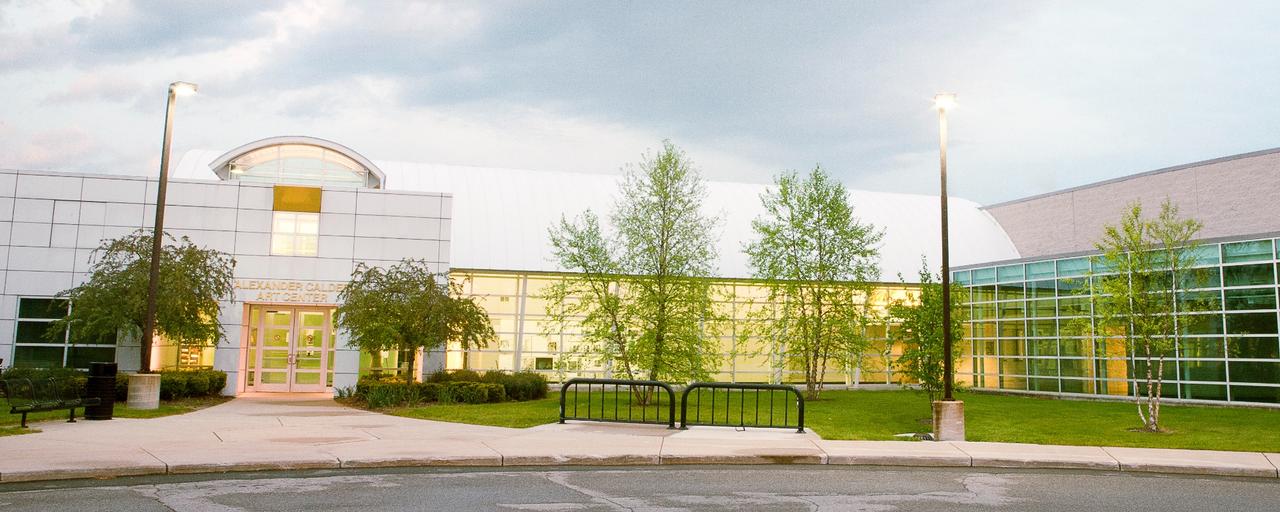Studio Art - B.A/B.S. - Curriculum and Requirements
Paired with their studio courses, students in the B.A./B.S. degrees integrate other areas of study at GVSU through foreign language or science courses, and a robust General Education program that prepares students for informed citizenship, leading to responsible participation in local, national, and global communities.
Your 4-Year B.A./B.S. Experience
Year 1: Exploration

B.A./B.S. students start their studies investigating multiple modes of practice in the Studio Art Major.
Year 2: 2D/3D

B.A./B.S. students continue their exploration in the Studio Art Major by engaging into a 2D and a 3D area of practice. They also start completing their requirements on their foreign language or science.
Year 3: Broadening

B.A./B.S. students continue to explore in the department by taking intermediate-level courses in studio art, and completing their foreign language or science requirements.
Year 4: Culmination

In your final year, you will wrap up degree requirements and start preparing for life after graduation.
First-Year Guide
This page should help guide your first-year registration at GVSU. If you want to pursue a BFA in Studio Art declare your major and emphasis right away so you can get full advising. You can change your major at any time.
B.A./B.S. Requirements
|
Requirements |
Credits |
|---|---|
|
15 |
|
|
6 |
|
|
6 |
|
|
6 |
|
|
9 |
|
|
3 |
|
|
9–12 |
|
|
≤ 45 |
|
|
18–21 |
|
|
Total |
120 Credits |
Foundations Courses (15 credits)
BA/BS-seeking students must complete five core classes included in the foundations' curriculum. These courses emphasize drawing, design, and problem-solving skills. This shared curriculum provides students with the conceptual, technical, and critical skills necessary for later studio work.
- ART 150 - Foundations: 2D Design and Color
- ART 151 - Foundations: 3D Design
- ART 152 - Foundations: Color and Design
- ART 155 - Foundations: Introduction to Drawing I
- ART 157 - Foundations: Introduction to Drawing II
Studio Art 2D Courses (6 credits)
Students must select two courses in different 2D areas from the list below for a total of 6 credits:
- ART 210 - Graphic Design Studio I: Introduction to Typography (3 credits)
- ART 257 - Life Drawing (3 credits)
- ART 260 - Introduction to Painting (3 credits)
- ART 265 - Introduction to Printmaking (3 credits)
- ART 280 - Special Topics in Art and Design (3 credits)
- ART 293 - Image Studio: Art, Production, Meaning, Display (3 credits)
Studio Art 3D Courses (6 credits)
Students must select two courses in different 3D areas from the list below for a total of 6 credits
- ART 245 - Fabricating Adornment: Jewelry Basics and Design (3 credits)
- ART 270 - Sculpture: Creating/Building/Making (3 credits)
- ART 275 - Ceramics: The Basics (3 credits)
- ART 295 - Space Studio: Art, Installation, Environment, Site (3 credits)
Studio Art Electives (6 credits)
Students must select two courses from the list below, for a total of 6 credits. Courses may contain pre-requisites.
- ART 307 - Digital Prepress (3 credits)
- ART 310 - Graphic Design Studio II: Typographic Systems (3 credits)
- ART 312 - Graphic Design IV - Experience Design (3 credits)
- ART 313 - Graphic Design for 3D Experiences (3 credits)
- ART 246 - Fluidity in Small Form: Jewelry Casting (3 credits)
- ART 347 - The Functional Metal Object in the Domestic Space (3 credits)
- ART 355 - Advanced Drawing I (3 credits)
- ART 356 - Advanced Drawing II (3 credits)
- ART 361 - Intermediate Painting I (3 credits)
- ART 362 - Intermediate Painting II (3 credits)
- ART 366 - Intermediate Printmaking I (3 credits)
- ART 367 - Intermediate Printmaking II (3 credits)
- ART 371 - Materials and Making: Digital Fabrication in Sculpture (3 credits)
- ART 372 - Mold Making and Casting: Digital Foundry in Sculpture (3 credits)
- ART 376 - Ceramics: Process (3 credits)
- ART 377 - Ceramics: Idea (3 credits)
- ART 380 - Special Topics in Art and Design (1 to 3 credits)
- ART 282 - Fundamentals of Illustration: Materials and Techniques (3 credits)
- ART 383 - Intermediate Illustration: World Building (3 credits)
- ART 391 - Civic Studio: Art in Public (3 credits)
- ART 392 - Curatorial Studio: Art, Exhibitions, Events (3 credits)
- ART 293 - Image Studio: Art, Production, Meaning, Display (3 credits)
- ART 394 - Interactive Studio: Art, Interface, Collaboration (3 credits)
- ART 295 - Space Studio: Art, Installation, Environment, Site (3 credits)
- ART 296 - Time Studio: Art, Video, Sound, Action (3 credits)
Art History Electives (9 credits)
Students must take three Art History courses, for a minimum of 9 credits. Courses may contain pre-requisites:
- ART 221 - Survey of Art History I (3 credits)
- ART 222 - Survey of Art History II (3 credits)
- ART 218 - Design History (3 credits) OR ART 219 - History of Illustration (3 credits)
- ART 322 - Goths to Gothic: Medieval Art (3 credits)
- ART 323 - Rethinking Renaissance Art (3 credits)
- ART 380 - Special Topics in Art and Design (1 to 3 credits)
- ART 420 - Asian Art (3 credits)
- ART 421 - Surrealism (3 credits)
- ART 422 - Art and the Worlds of Islam (3 credits)
- ART 423 - Animals in Art (3 credits)
- ART 425 - Depicting a Nation: 19th Century American Art (3 credits)
Capstone (3 credits)
Students must complete the required capstone course, for a total of 3 credits.
- ART 495 - Issues In Art (3 credits)
Degree Requirements (9–12 credts)
Students must complete the degree requirements that align with their degree of choice.
Bachelor of Arts option
The Bachelor of Arts (B.A.) degree requires a three-semester proficiency in a foreign language. Many students with high school experience with a language enjoy the opportunity to improve their knowledge and speaking skills with that language and to learn more about the corresponding culture/s. Others choose a different language, having demonstrated an aptitude for speaking foreign languages. This is a good choice if you plan to continue your studies to attain a Graduate or PhD degree.
- Third-semester proficiency in a foreign language (12 credits)
Bachelor of Sciences Option
The Bachelor of Science (B.S.) degree requires that you complete the following three courses:
- CIS 150 - Introduction to Computing (3 credits)
- STA 215 - Introductory Applied Statistics (3 credits)
- STA 216 - Intermediate Applied Statistics (3 credits) OR HST 290 - Research Methods in History (3 credits)
General Education Courses (≤ 45 credits)
The Grand Valley State University General Education Program provides a broad-based liberal education experience that fosters lifelong learning and informed citizenship. The Program prepares students for intelligent participation in public dialogues that consider the issues of humane living and responsible action in local, national, and global communities.
Students must refer to the General Education Handbook for information on General Education Course Offerings.
Please visit https://www.gvsu.edu/math/mathematics-placement-11.htm for more information.
- Writing (WRT130 or WRT150 Students must receive a grade of C (not C-) or better to fulfill this requirement.)
- Physical Sciences (1 course)
- Life Sciences (1 course)
- Science Lab (1 course)
- Arts (1 course; fulfilled by ART 153)
- Philosophy and Literature (1 course)
- Mathematical Sciences (1 course; MTH110 pre-requisite)
- Social and Behavioral Sciences (2 courses)
- Historical Analysis (1 course)
- SWS courses should be taken after fulfillment of GE Foundations - Writing.
- You must receive a grade of C (not C-) or better in GE Foundations - Writing and both SWS courses to fulfill this requirement.
- SWS Course #1
- SWS Course #2
(Note: SWS sections of ART 221 and 222 will fulfill your SWS requirement)
Global Perspectives (1 course)
U.S. Diversity (1 course)
- You may choose your Issues courses from the same category (Globalization, Health, etc.) or from different categories.
- You must choose two courses from two different disciplines/course prefixes.
- If a course is cross-listed in two disciplines/course prefixes, your second course must be taken from a third discipline/course prefix.
- Issues courses must be taken at GVSU (except study abroad, see www.gvsu.edu/studyabroad).
- Issues courses have a junior standing prerequisite.
Elective Courses
Students must complete the number of free elective credits that, combined with the requirements above, total the 120 credits required for graduation at GVSU.
QUESTIONS?
If you have questions, please reach out to any of the three people in your Advisor Network.
- Your faculty advisor (see Who's My Advisor?)
- Doris Penn, CLAS Academic Advisor, [email protected]
- Sonja Wall, CLAS Academic Advisor, [email protected]

